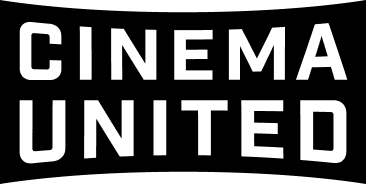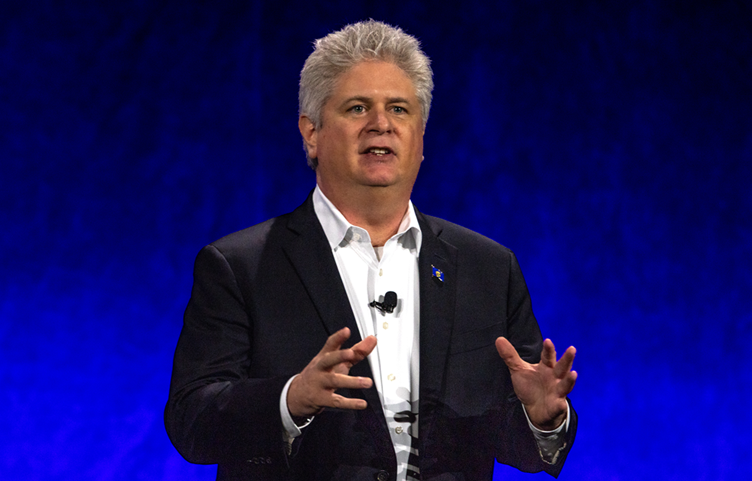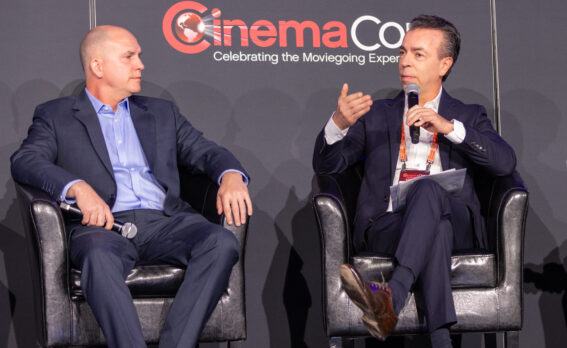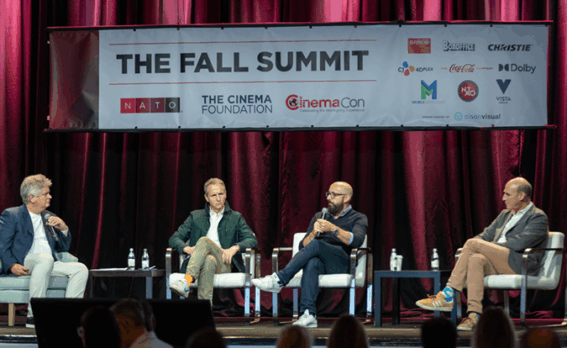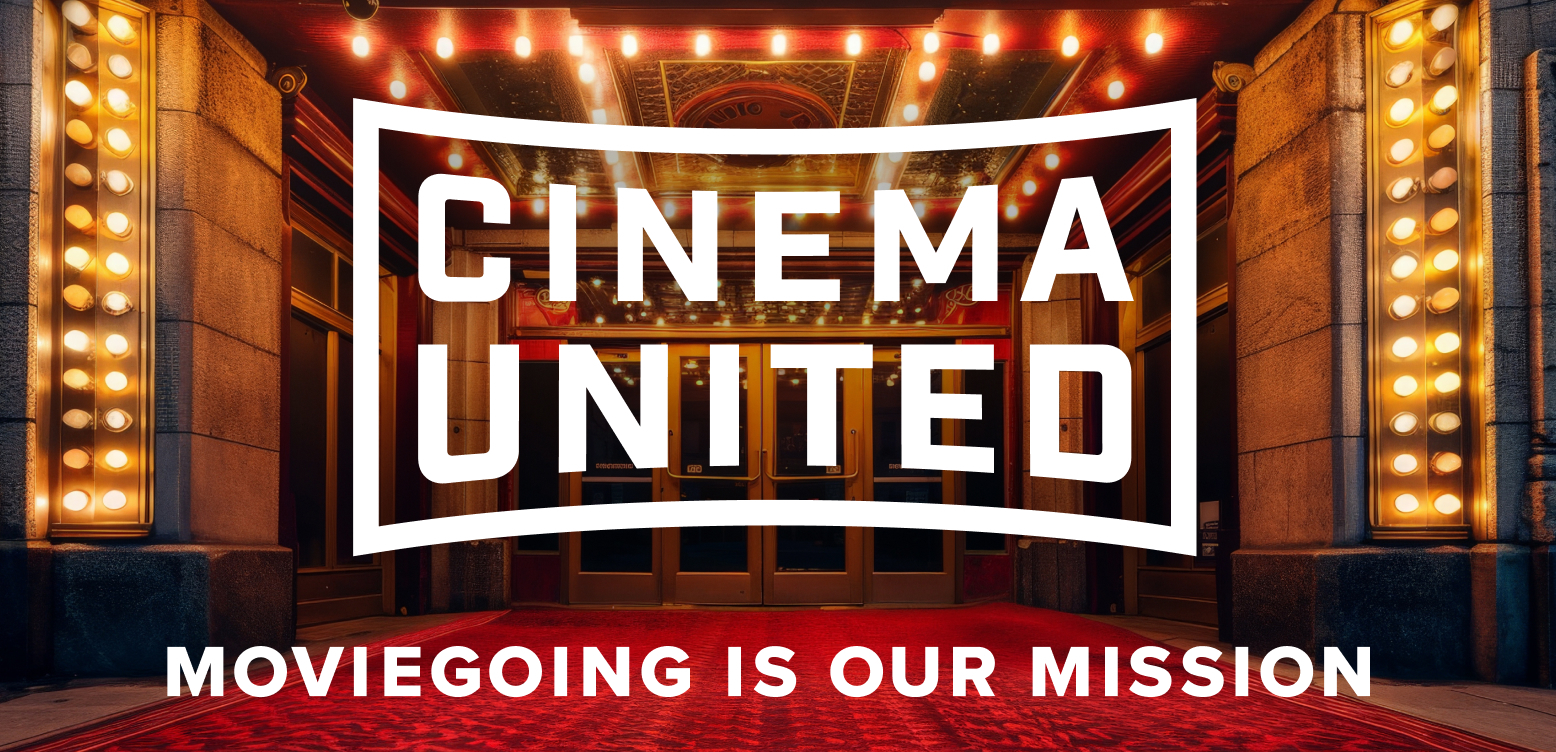The full speech is below:
INTRO
- My focus today is the future, and how we can, together, write the next chapter in this amazing industry.
- This will come as news to the cynics, but I believe that our industry is on the cusp of the next great era of cinema.
- Our singular goal must be to work every day to ensure that going out to the movies remains the premier entertainment option for people the world over.
- The past few years, while turbulent and challenging, have taught us a great deal, and reinforced some important truths.
- We are recovering, but not fully recovered. The future is promising, but there is work to be done – work that must be done, not just by exhibition, but by everyone that believes in the cultural and economic impact of movies on the big screen.
- We arrive in Las Vegas tougher, smarter and more resilient because of our experiences, but focused squarely on the future.
- Everyone feels the pressures of today’s marketplace – from the biggest studios to the one-screen independents.
- But clinging to the norms of a pre-pandemic world or to the temporary adjustments made during that time, threatens the overall health of this great industry.
- We need a system that recognizes our common goals and does not pit one sector against another in a short-sighted quest for immediate financial return at the cost of long-term success.
- Now is the time for us to take what we know, and what we have learned and craft a model that will thrive for generations.
EXCLUSIVITY - As it has always been, a clear, consistent period of exclusivity, supported by meaningful nationwide marketing from both distribution and exhibition, is essential for
all theatrically released films to be successful. It is the bedrock upon which our collective prosperity is built. - Exclusivity doesn’t just benefit exhibition. It benefits filmmakers, actors, studios and the movie-going public, provided the window is long enough.
- Windows that are too short, or inconsistent, only lead to confusion among consumers, particularly among casual moviegoers who are so important.
- The perception, or more importantly, the reality at times, that everything will be available on other platforms in a matter of weeks, undercuts the sustainability of the entire industry by negatively impacting the frequency of movie fans going to the theatre.
- We can see the impact of windows on box office recovery throughout the world. As you can see, in countries with longer windows, the box office recovery has been greater.
- Shorter windows reduce the number of people that head to the theatre in the opening weeks of a release. It hits the bottom-line, and in many cases, undermines the ability of medium or smaller-budget movies to build an audience or even get off the ground.
- If you compare the box office results of the top 100 films per year, pre and post pandemic, we see that the top 20 movies declined by 10% but the box office of the next 80 movies – the small and mid-size movies that are so important – declined by a full 32%.
- When you consider the relevant windows, 49 days was the average for the top 20 movies. However, the next 80 fall all the way to 31 days. The corresponding drop in box office is not surprising.
- If we can limit the decline of those 80 movies to the same 10% decline as the top 20 – it would add over $1 billion to the annual box office. So how do we do that?
- To be fair, there is no single reason that these 80 movies dropped so severely, but shorter windows, and the reality that consumers expect these movies to be in the home within 3-4 weeks, is a major factor.
- Longer windows, supported by marketing would reduce the current level of decline, and create more revenue across the industry.
- Everyone benefits from these movies flourishing…including movie fans.
- Beyond box office receipts, shorter windows also undermine the long-term viability of exhibition—and every stakeholder in this industry needs a vibrant network of theatres to make their business models work.
- If we continue to shorten windows, and crowd out the small and medium sized movies, creating the impression that the only reason to go to the theatre are the big blockbusters, then eventually, the very network needed to make those blockbusters successful, will atrophy.
- We cannot sacrifice long-term success for short-term gain.
- That said, we recognize that the nature of windows has undeniably changed.
- Gone are the days of a minimum 90-day theatrical window for all movies, and we understand the desire for the flexibility to shift movies which have maximized their
theatrical performance to other platforms to recoup investment. - But there must be a baseline, and for most movies, the ultimate box office success and consumer demand cannot be effectively determined short of a 45-day window.
- A clear, consistent starting point is necessary to affirm our collective commitment to theatrical exclusivity and to provide clear expectations for movie fans.
- A compelling movie will do just as well on PVOD at 45 days as it would at 20 AND it would have the benefit of added marketing impact, publicity and word-of-mouth from additional time in the theatre, and additional revenue as well.
- It’s not a zero-sum game. The goal is to make the pie bigger, for everyone.
MARKETING - An important aspect of theatrical exclusivity where distribution and exhibition can work effectively together is marketing.
- We see amazing marketing efforts all the time in this industry, but it’s harder and harder to connect with consumers today.
- It takes time to maximize the impact of marketing, and results are undercut by windows that are too short, resulting in less revenue being earned in the theatrical window.
- Recent data from NRG shows that audience awareness of new movies has been dropping, with a 38% decline in movies that reached an awareness level over 50% by
opening weekend. - Rasing awareness is not solely the responsibility of studios. Exhibition must do everything we can to help drive marketing to all demographics.
- Moving forward, our goal should be audience awareness of over 50% for all wide releases. We live in a time of pervasive and relentless communication, and there is no excuse not to attain this target if exhibition and distribution work together.
- If fewer than half of movie-goers are aware of a new movie, can we sincerely say we are working to build a robust theatrical business?
- A good starting point would be an aggressive re-commitment to emphasizing “Only in Theatres” across all marketing platforms.
- General marketing that is neutral as to the format, in addition to format-specific marketing, will benefit theatres of all sizes.
- Also, we should not be promoting or pre-ordering “see-at-home” options while a movie is still in theaters, and “at-home” should never be the default app option while a movie can still be seen in thousands of theatres across the country.
- Additionally, everything that happens in the auditorium is part of the moviegoing experience.
- Imagine the positive response if, hypothetically, the preshow was tailored, the green band rating, as appropriate, appeared only before the first trailer, the trailers were 90 seconds in length, and exhibition played between four and six before a movie? The marketing impact would be greater, and the guest experience would be better.
SCHEDULING and ACCESSIBILITY - Similarly, scheduling requirements which result in a G or PG-rated family-movie being played at 10:15 pm on a school night when the theatre owner knows there is no
audience for it, doesn’t make sense for movie fans, the exhibitor or the distributor. - Exhibition knows their guests better than anyone and exhibition should never stop working to use that knowledge to enhance everyone’s return on investment.
- A little over a decade ago, our industry ushered in the digital transition, making the ability to get a movie to any theatre seamless and significantly less expensive. The promise of digital was greater access at a reasonable price.
- We need more movies for the hundreds of independent theatres that dot this great nation. Theatres that serve the good people of small towns and rural communities
across America and the world. With today’s technology, the incremental expense is negligible. For example, in places like Forsyth, Montana, people drive upwards of 40 miles, through all kinds of weather, to go to the theatre. If someone makes that commitment to go to the movies, we owe it to them to offer the most compelling options available. - Speaking of independent theatres, hold requirements should not extend beyond the time a movie is exclusively in theatres.
- Also, if an independent operator feels passionate about playing a movie, they should be able to confirm it early, so they have the same opportunity as their competitors to adequately market it to their guests.
REINVESTMENT/EXPERIENCE - Of course, exhibition has a huge responsibility in this next great era of cinema, as well. We must do our part.
- We must keep our theatres updated, clean and well-managed. This must always be a priority.
- Vibrant, comfortable, cinemas are essential to getting moviegoers to return time and time again. It’s about the experience!
- Exhibition is continuing to make enormous investments in their theatres and will continue to do so in the years ahead. As we showed in our report last week, there is amazing work being done out there—and I encourage you all to experience it.
- Today, I renew my invitation to our studio partners and friends in the creative community, and the entertainment media, particularly those on the coasts, to please visit some of these theatres across this great nation and witness what it truly means to go to the movies in America.
- We must continue to invest in all aspects of the moviegoing experience, from projection, sound and lighting to concessions, food and beverage, lobby and parking areas. All the pieces matter.
- Going to the movie theatre is and needs to remain a great entertainment value proposition for people all around the world. However, to maintain that status, we must
continue to create innovative business approaches that reflect a changing market, and consumer demand to ensure value for audiences.
PLFS - We should continue to invest in the experiences people want – this includes large screen formats.
- Yet recognize that they account for only 9% of the global box office.
- Investment in large screen formats cannot be at the expense of other auditoriums. Every experience at the local theatre is and must continue to be a PREMIUM experience.
- If, in our collective zeal to promote large screen experiences, we lead movie lovers to believe that the only reason to go to the theatre is for large screen formats, we are destroying the very heart of our business.
- Movie fans want options, and we must meet those demands and ensure that every experience is a premium one.
CONCLUSION - As we look to our future, we do so with a clear understanding of our collective history.
- We also know the road ahead will present challenges.
- But if, as we have in the past, we have the courage and commitment to address them together, we will succeed.
- So today, I am closing with a call-to-action.
- To call on leaders in both exhibition and distribution to come together, in good faith and good spirit, and have candid conversations about how we can collectively make our industry better.
- Come together, discuss challenges and create solutions that respect competition, recognize market conditions, consumer needs and demands and enhance the overall business we all love. The world is different today than it was yesterday, and we must not just adapt, but evolve if we want to realize our future potential.
- The goal is growing the business, growing revenue, giving movie fans more options – in a way that benefits everyone collectively.
- The studios’ success is our success, and ours is theirs. And if we get it right, movie fans the world over will be the true beneficiaries.
- There is no reason we cannot succeed, but we must do things differently.
- CinemaCon embodies the best of our industry. The passion and innovation of exhibition, and the creativity and vision of distribution come together, and for one amazing week, the energy, optimism and promise are unmatched.
- We need that same energy, optimism and promise to address the tough issues we face and collectively chart a successful path to a bright future.
- We know the issues we face, and we must dedicate ourselves to the hard business of resolving them.
- We are on the brink of the next great era of cinema…
- Let’s get to work.
